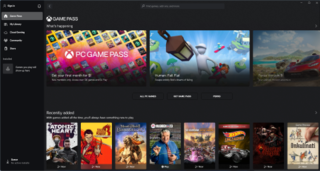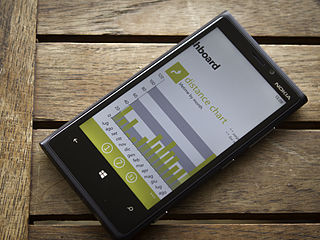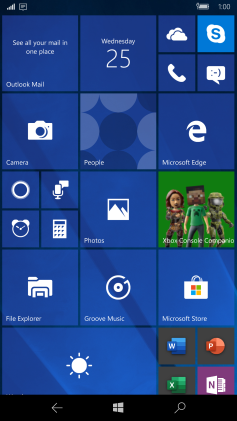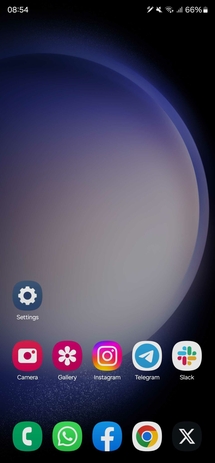
Windows Phone (WP) is a discontinued mobile operating system developed by Microsoft Mobile for smartphones as the replacement successor to Windows Mobile and Zune. Windows Phone featured a new user interface derived from the Metro design language. Unlike Windows Mobile, it was primarily aimed at the consumer market rather than the enterprise market.
This page provides details for the version history of the Microsoft's Windows Phone branded mobile operating systems, from the release of Windows Phone 7 in October 2010, which was preceded by Windows Mobile version 6.x.

Microsoft Lumia is a discontinued line of mobile devices that was originally designed and marketed by Nokia and later by Microsoft Mobile. Introduced in November 2011, the line was the result of a long-term partnership between Nokia and Microsoft—as such, Lumia smartphones run on Microsoft software, the Windows Phone operating system; and later the newer Windows 10 Mobile. The Lumia name is derived from the partitive plural form of the Finnish word lumi, meaning "snow".

The Xbox app is an app for Windows 8, Windows 10, Windows 11, Android, iOS and Tizen. It acts as a companion app for Xbox video game consoles, providing access to Xbox network community features, remote control, as well as second screen functionality with selected games, applications, and content.

Microsoft Surface is a family of touchscreen-based personal computer, tablet, and interactive whiteboard hardware products designed and developed by Microsoft. The majority of them run the Windows operating system and use Intel processors.

Nokia Lumia 920 is a smartphone developed by Nokia that runs the Windows Phone 8 operating system. It was announced on September 5, 2012, and was first released on November 2, 2012. It has a 1.5 GHz dual-core Qualcomm Krait CPU and a 4.5" IPS TFT LCD display, as well as a high-sensitivity capacitive touchscreen that can be used with gloves and fingernails; the display is covered by curved Gorilla Glass and has a 9 ms response time. The phone features an 8.7-megapixel PureView camera with OIS; it was the first smartphone camera to implement that technology, as well as to support Qi inductive charging. The phone comes with 32 GB of internal storage, but has no expandable storage.

Windows Phone 8.1 is the third generation of Microsoft Mobile's Windows Phone mobile operating system, succeeding Windows Phone 8. Rolled out at Microsoft's Build Conference in San Francisco, California on April 2, 2014, it was released in final form to Windows Phone developers on April 14, 2014 and reached general availability on August 4, 2014. All Windows Phones running Windows Phone 8 can be upgraded to Windows Phone 8.1, with release dependent on carrier rollout dates.

The Nokia X family was a range of budget smartphones that was produced and marketed by Microsoft Mobile, originally introduced in February 2014 by Nokia. The smartphones run on the Nokia X platform, a Linux-based operating system which was a fork of Android. Nokia X is also known generally as the Nokia Normandy. It is regarded as Nokia's first Android device during the company's Microsoft partnership and was in the process of selling its mobile phone business to Microsoft, which eventually happened two months later.

The HTC One (M8) is an Android or Windows smartphone manufactured and marketed by HTC. Following a number of leaks that occurred during the months prior, the device was officially unveiled in a press conference on March 25, 2014, and released the same day by Verizon Wireless at retail, and by other Canadian and United States carriers for online orders prior to its wider retail availability in mid-April.

The Nokia X2 is an entry-level smartphone which was announced and released by Microsoft Mobile on 24 June 2014. It is the successor of the Nokia X, being the first smartphone running version 2.0 of the Android-based Nokia X platform operating system. The Nokia X family of Android phones was discontinued on July 17, 2014.

Windows 10 Mobile is a discontinued mobile operating system developed by Microsoft Mobile. First released in 2015, it is the successor to Windows Phone 8.1, but was marketed by Microsoft as being an edition of its PC operating system Windows 10.

The Microsoft Lumia 650 is a smartphone developed by Microsoft, officially revealed on February 15, 2016. It is the successor to the Microsoft Lumia 640 and is aimed primarily at business users, with support for Microsoft's business applications as well as security features like device encryption and remote wiping. Due to hardware limitations, it does not support Continuum. The phone was available in both single- and dual-SIM variants and is the most recent model in the Lumia series, with Microsoft discontinuing Lumia hardware production the following year, pivoting to dual-screen devices under the Surface Duo brand.

One UI is a user interface (UI) developed by Samsung Electronics for its smart devices, including Android devices running Android 9 (Pie) and later. Succeeding Samsung Experience, it is designed to make using larger smartphones easier and be more visually appealing. It was announced & unveiled at Samsung Developer Conference in 2018, and was updated in Galaxy Unpacked in February 2019 alongside the Galaxy S10 series, Galaxy Buds and the Galaxy Fold.

The Samsung Galaxy Fold is an Android-based foldable smartphone developed by Samsung Electronics. Unveiled on February 20, 2019, it was released on September 6, 2019, in South Korea. The device is capable of being folded open to expose a 7.3-inch tablet-sized flexible display, while its front contains a smaller "cover" display, intended for accessing the device without opening it. With the announcement of the Galaxy Z Flip, Samsung's foldable phones were made part of the Galaxy Z series. This also retroactively applies to the Galaxy Fold.

Xbox Cloud Gaming is a cloud gaming service as part of Xbox offered by Microsoft Gaming. Initially released in beta testing in November 2019, the service later launched for subscribers of Xbox Game Pass Ultimate on September 15, 2020. Xbox Game Pass cloud gaming is provided to subscribers of Ultimate at no additional cost. Xbox Cloud Gaming operates by linking the device to a remote server in the cloud.

A foldable smartphone is a smartphone with a folding form factor. It is reminiscent of the clamshell design of many earlier feature phones. Some variants of the concept use multiple touchscreen panels on a hinge, while other designs utilise a flexible display. Concepts of such devices date back as early as Nokia's "Morph" concept in 2008, and a concept presented by Samsung Electronics in 2013, while the first commercially available folding smartphones with OLED displays began to emerge in November 2018.
The Surface Neo is an unreleased dual-touchscreen 2-in-1 PC that was unveiled by Microsoft on October 2, 2019. Slated to be part of the Microsoft Surface family of devices, the Surface Neo was designed to be used in various "postures" for different use cases and multitasking scenarios involving its screens, and feature Windows 10X—a variant of Windows 10 designed exclusively for dual-screen devices. However, as of December 2023, over four years after the Surface Neo was announced, it is still unreleased, likely rendering it vaporware.

The Samsung Galaxy A41 is a mid-range Android smartphone developed by Samsung Electronics as part of their 2020 A-series smartphone lineup. It was announced on 18 March 2020, and first released in Europe on 22 May 2020 as the successor to the Galaxy A40. The phone comes preinstalled with Android 10 and Samsung’s custom One UI 2.1 software overlay, but was upgraded to Android 12 and One UI 4.1 with the updates starting on 29 September 2022.

Bootloader unlocking is the process of disabling the bootloader security that makes secure boot possible. It can make advanced customizations possible, such as installing custom firmware. On smartphones, this can be a custom Android distribution or another mobile operating system. Some bootloaders are not locked at all and some are locked, but can be unlocked with a command or with assistance from the manufacturer. Some do not include an unlocking method and can only be unlocked through a software exploit.

The Surface Duo 2 was a dual-touchscreen Android smartphone manufactured by Microsoft. Announced during a hardware-oriented event on September 22, 2021, it is the successor to the original Surface Duo.

















